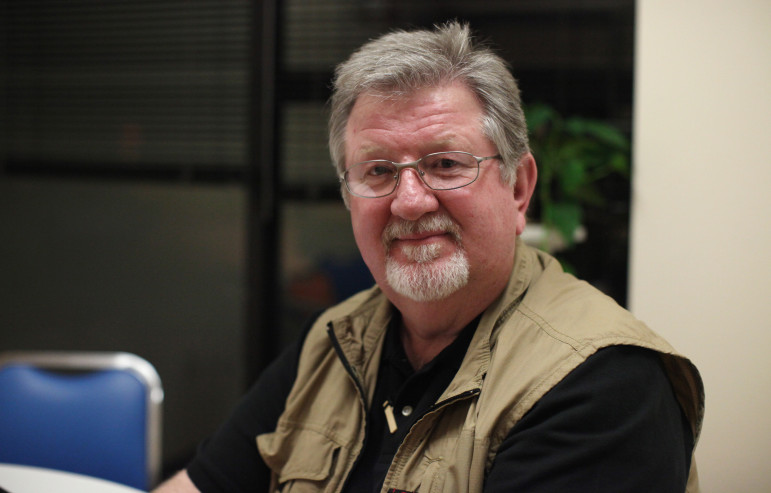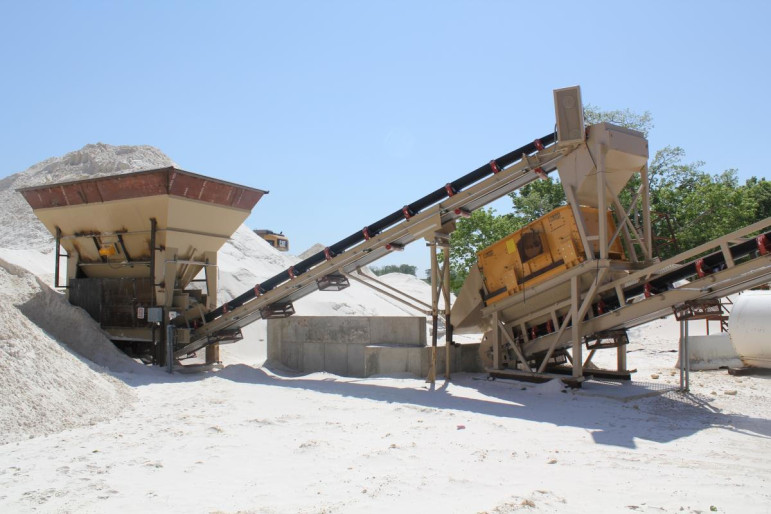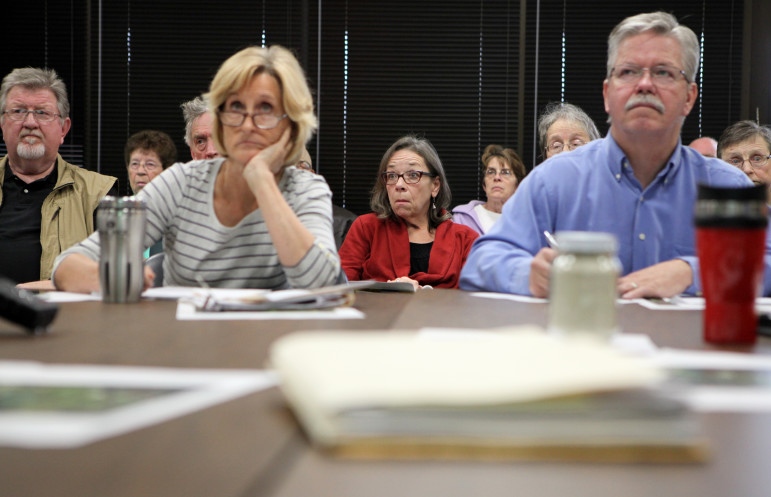Frac Sand Mine is Nation’s Worst Violator
Huge mine on Iowa border plans seven-fold expansion, leads in workplace violations.
Official defends company record
Tim Adkins, who joined Pattison Sand 14 months ago as its health and safety director, said after the April 28 meeting that claiming Pattison Sand’s record is the worst in the industry is a “terrible, terrible, misconception” and an “out-of-context statement to make.” He attributed some of the past violations to lack of experience by the Pattison family, who used to store and ship grain from the underground caverns that are now mined.
“When they (Pattison Sand) went into the mining industry, they didn’t know about the mining industry. They’d never dealt with MSHA. They didn’t know MSHA regulations,” said Adkins, who has over 40 years of experience as a health and safety professional, including over 35 years in mining.

Pattison Sand Co. health and safety director Tim Adkins is seen after the meeting of the Mine Reserve Expansion Study Committee. Adkins said labeling Pattison Sand’s workplace violations record as the worst of its kind in the country is a “terrible, terrible misconception.” Photo by Coburn Dukehart of the Wisconsin Center for Investigative Journalism.
Adkins added that underground mines such as Pattison Sand’s generate more violations because they are inspected twice as often as surface mines, four times a year versus two.
“Pattison Sand is a good player, good operator,” Adkins said. “They care about their employees, they take extra steps to go above and beyond MSHA requirements, MSHA standards.”
But even when compared to other similar underground mines, Pattison’s track record is not stellar. In 2010, 2011 and 2014, the company’s Iowa mine had above-average rates among underground metal and nonmetal mines of violations deemed “significant and substantial” by MSHA. Data prior to 2010 were not available.
Adkins said Pattison Sand works very closely with MSHA to ensure compliance. That was not always the case.

At Pattison Sand Co., seen here in 2011, fine-grained silica sand is funneled onto conveyor belts that move it through a giant, hissing rotary dryer, which uses heat to dry any wetness the sand retains after being washed. Some residents living around Pattison Sand’s proposed expansion at its site in Clayton County, Iowa, are concerned about being exposed to silica dust, which can cause lung damage if inhaled. Photo by Kathleen Masterson of Harvest Public Media.
In 2011, Pattison Sand sued the agency after it shut down the majority of the underground mine following multiple roof collapses, including one in which at least 30 tons of rock fell onto an excavator; the miner operating it was unhurt. The lawsuit and appeals kept the underground part of the mine closed for several months.
Besides Pattison’s Iowa mine, MSHA lists only two other underground industrial sand mines in the country. Both are located in Pierce County, Wisconsin, and operated by the Wisconsin Industrial Sand Co. Since 2005, one of the mines has received 279 violations — a fraction of the number racked up by Pattison. The other, operating only since 2008, has received 127 violations.
Opponents continue to fight
At the April 28 meeting in Elkader, 37 people submitted comments raising questions about Pattison Sand’s record of MSHA violations, burning at the company’s Iowa site, workers’ respiratory problems, conflicting results of air quality studies and dust.

Kathy Kachel, center, a Wisconsin homeowner whose house overlooks Pattison Sand Co.’s Iowa operations, reacts to testimony given by University of Iowa professor Patrick O’Shaughnessy at a meeting of the Mine Reserve Expansion Study Committee in Elkader, Iowa. In the foreground are committee members Anne Osmundson and Tom Blake. Photo by Coburn Dukehart of the Wisconsin Center for Investigative Journalism.
Kathy Kachel, who attended the meeting, blames Pattison Sand’s Iowa mine for the white sand she dusts inside her house. She lives in Bagley and can see the facility from her porch. Kachel would like to see it shut down.
“There is a proliferation of silica (sand) at this point for fracking,” Kachel said. “It’s not healthy for anybody — the environment, the wildlife, my grandchildren.”
In Wisconsin, Pattison Sand operates a surface mine in Bridgeport, about a 30-minute drive northeast of its Iowa site. Four Bridgeport residents and the Crawford Stewardship Project, an environmental group that promotes sustainability and local control of natural resources, tried unsuccessfully to block that mine. Its status is currently listed as “intermittent” based on the number of hours worked at the site.
Since it began operating in August 2013, the Bridgeport mine has received seven violations for which the company paid $824 in fines. Those violations include failing to notify MSHA before starting operations, neglecting to prepare a material safety data sheet for each hazardous chemical the mine uses or produces, failing to provide first aid materials, and failing to provide safe means of access to travelways.
Garcia-Rivera said violations at mines that are not yet fully operational, such as Pattison Sand’s Bridgeport site, are to be expected. MSHA is only required to inspect such intermittent surface mines once a year. The mine expansion committee plans to meet again on Wednesday.
Digital and multimedia director Coburn Dukehart contributed to this report. The nonprofit Wisconsin Center for Investigative Journalism (www.WisconsinWatch.org) collaborates with Wisconsin Public Radio, Wisconsin Public Television, other news media and the University of Wisconsin-Madison School of Journalism and Mass Communication. All works created, published, posted or disseminated by the Center do not necessarily reflect the views or opinions of UW-Madison or any of its affiliates.
Article Continues - Pages: 1 2
-
Few SNAP Recipients Reimbursed for Spoiled Food
 Apr 9th, 2024 by Addie Costello
Apr 9th, 2024 by Addie Costello
-
Claire Woodall’s Plan to Restore Trust in Milwaukee’s Election Process
 Apr 8th, 2024 by Alexander Shur
Apr 8th, 2024 by Alexander Shur
-
Wisconsin’s Medicaid Postpartum Protection Lags Most States
 Feb 27th, 2024 by Rachel Hale
Feb 27th, 2024 by Rachel Hale














